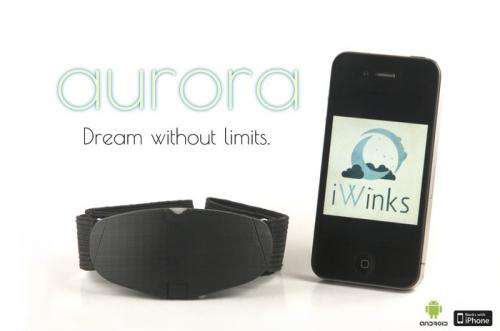January 18, 2014 weblog
Cobweb or cotton candy? Headband aims to control dreams

(Medical Xpress)—A dream can be explained as a story that happens while we sleep. Some have dreaded dreams at one time or another of climbing a stairwell that never ends or meeting up with a monster or facing impossible obstacles on the run. Apparently the opportunity to reverse dreaded dreams and instead experience lucid dreaming has captured the attention of many Kickstarter visitors. They are showing interest in a sleep-tracking headband campaign. With three days to go, at the time of this writing, the fundraisers have realized $206,031 in pledges surpassing their $90,000 goal. Those running the campaign are offering a lucid dreaming device called Aurora.
The company is iWinks in San Diego, and they have designed a headband to help people control their dreams. How it works: The user puts on the headband, goes to sleep, and the headband measures brain waves and eye movement activity and can tell when the sleeping user enters the dream stage. Aurora emits lights so the user knows a dream state is going on.
But wait. Why would you want to be jolted out of your sleep by lights? The lights, say the creators, do not wake the user up, but, instead, help the dreamer reach a lucid dream state where the user has the opportunity to turn something alarming into something pleasing. The person can coordinate a spectrum of light effects from the Aurora with sounds from the person's music library or personal recordings; to direct the dream experience.
iWink co-founder, Daniel Schoonover and team are asking for support to be able to realize a polished product. The company has turned to Kickstarter for funds that will be applied to manufacturing a sleek design. Schoonover first began designing a circuit from the ground up, using a Bluetooth 4 LE (Low Energy) module and an EEG amplifier licensed from NeuroSky, the .biosensor technology company. The Bluetooth technology enables connections to Android, iOS, and desktop devices.
According to the team, "our experiments with real-time sleep stage detection have proven very accurate with 90 percent of our experimental subjects." They have used a partnering sleep clinic to collect preliminary data, and look forward to crowdsourcing for more data. "After release, we'll still collect user feedback, anonymous statistics and release software updates," they said.
Writing in their I winks blog, they said that the partnering sleep clinics collected data with Aurora prototypes following rigorous scientific protocol. The headband was worn to bed by test subjects, and later professionally trained sleep technicians assigned sleep-stage labels to each 30 second-epoch. This information led them to create a first iteration of their algorithm to estimate sleep stages. The company intends to use the following months to finalize designs and test first production models. By March they want to send out beta master developer headbands, and they target June for shipping. A pledge of $175 or more gets one Aurora headband and access to smartphone and desktop applications.
The lucid dreaming phenomenon is a centuries-old topic, which can be dated back to the time of Aristotle, who is said to have observed something in consciousness going on even when one is sleeping, which "declares that what then presents itself is but a dream". A past report from the BBC observed references to lucid dreaming stretch back to Tibetan Buddhists in the eighth century, for whom it was a stage in the practice of "dream yoga."
More information: www.kickstarter.com/projects/i … m-enhancing-headband
© 2014 Medical Xpress



















